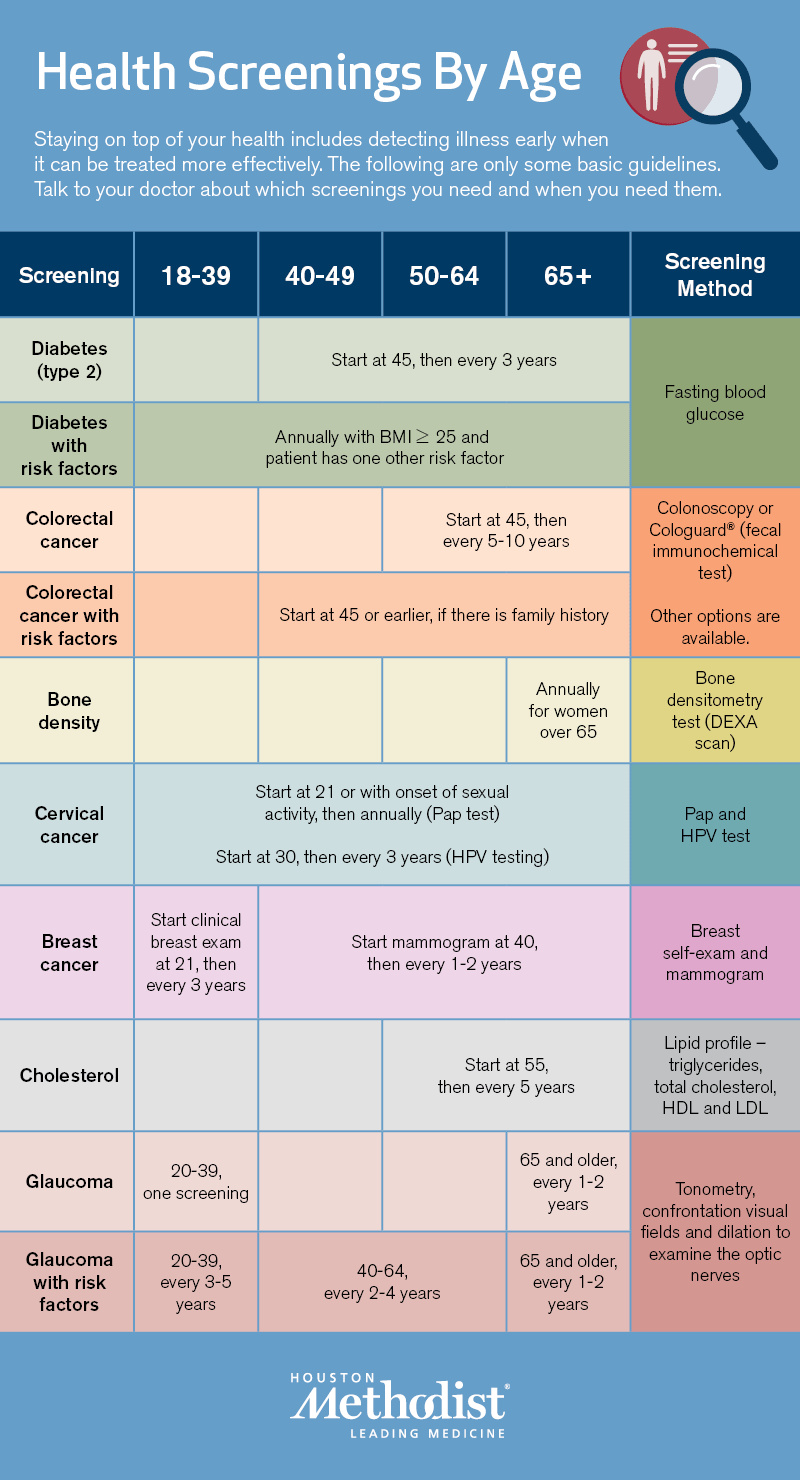Too often, many of us take a reactionary approach to our health, especially when struggling to balance all the demands in our lives. Women are often pulled in many directions. Between the kids, work, marriage, parents and community activities, caring for themselves and their health becomes an afterthought.
You may think that just because everything feels OK, nothing can be wrong, but not being screened is like telling the kids they don't have to wash their hands if they don't see any germs.
The reality is that each stage of our lives brings its own health concerns, and getting the recommended health screenings is a great way to be proactive about your health — especially if there is a family history. Even if the tests confirm suspicions, early detection is critical.
Health screenings can give patients a glimpse into the future. They can help determine the risk for developing certain diseases or help catch diseases early. Many screenings simply involve drawing blood and/or conducting a physical exam.
The following are some basic guidelines for various health screenings. Talk to your doctor about which screenings you need, and when you need them. Many illnesses, when detected early, can be more effectively treated or cured.
1. Type 2 diabetes screening
Due to the nation's expanding waistline, type 2 diabetes is now a national epidemic. A disease traditionally associated with older adults also now afflicts children as well.
Diagnosing type 2 diabetes early is essential. Besides of the long list of complications when the disease is not well-managed, type 2 diabetes doubles a person's chances of developing heart disease and stroke.
When should you be screened for type 2 diabetes?
Healthy adults should be screened every three years beginning at age 45. Those with a body mass index (BMI) greater than 25 and who have one other risk factor should be screened annually.
What are the risk factors for type 2 diabetes?
Risk factors for type 2 diabetes include:
- Being overweight
- Having a family history of type 2 diabetes
- Living a sedentary lifestyle
- Low HDL (the "good" cholesterol)
- High blood pressure
- High triglycerides
- Being of a certain racial or ethnic group, such as Black, Hispanic, Asian or Native American/Alaska native
How is the type 2 diabetes screening performed?
Screening for diabetes involves a simple blood test to determine the fasting blood glucose.
2. Colorectal cancer screening
Colorectal cancer is the second leading cause of cancer-related death in the U.S. in men and women combined. With proper screening, 60% of those deaths could have been avoided.
"On a national level, people are not getting the screening they need," says Dr. Gulchin Ergun, a gastroenterologist at Houston Methodist.
Dr. Ergun notes that precancerous polyps can be found in the colon and rectum up to 10 years before cancer develops.
"That is why patients with who have a family history of colon cancer should start screening 10 years before the age their close relatives developed cancer," she adds.
When should you be screened for colorectal cancer?
Both men and women should be screened for colorectal cancer starting at age 45. (Related: Why Even Young Adults Should Care About Colorectal Cancer Screening)
What are the risk factors for colorectal cancer?
Colorectal cancer risk increases with age, so anyone over 45 or who has the presence of polyps, a family or personal history of colorectal cancer, ulcerative colitis or Crohn's disease is at risk. A diet high in red meat and low in fiber also puts you at risk.
How is colorectal cancer screening performed?
The preferred screening tool is colonoscopy, which is a procedure in which the doctor uses a long, flexible tube with a small camera mounted on it. The tube is inserted into the anus and guided through the rectum and colon. Usually a mild sedative and narcotic are administered before the procedure.
Stool-based tests, such as the Cologuard®, offer an at-home testing option that requires no special preparation. The patient simply collects the sample and sends it to the lab.
3. Cholesterol screening
High cholesterol is a major risk factor for developing heart disease, so it's important for you to know your numbers,
In adults, a primary care doctor will often order a lipid profile along with a complete blood count as part of a patient's regular checkup. Of special interest is the patient's low-density lipoprotein (LDL), sometimes referred to as "bad" cholesterol. This is where diet, exercise and medication can have the most impact.
When should you be screened for high cholesterol?
Women should begin screening at 55, but doctors often check cholesterol levels during an annual physical exam.
What are the risk factors for high cholesterol?
Risk factors for high cholesterol include:
- Eating a poor diet
- Being overweight
- Having a family history of high cholesterol
How is cholesterol screening performed?
A cholesterol screening is performed by a blood test.
4. Osteoporosis screening (bone density test)
As we get older, we lose bone density. The bone density scan checks for calcium and other key minerals in the bones. Less dense bones are at higher risk for fracture. This can be a sign of osteoporosis, when bones become so weak and brittle that even mild stresses, like bending or coughing, can result in fracture.
When should you be screened for osteoporosis?
Women over 65 years old should have a bone mineral density (BMD) test performed to assess their risk for osteoporosis.
What are the risk factors for osteoporosis?
Risk factors for osteoporosis include:
- Having a bone fracture when over age 50
- A history of rheumatoid arthritis, chronic kidney disease or an eating disorder
- Early menopause
- History of hormone treatment for breast cancer
- Family history of osteoporosis and loss of height
Women who are either white or from Southeast Asia are at a higher risk. Additionally, long-term use of steroids, such as prednisone, increases the risk of osteoporosis. Also, taking certain hormones, such as progesterone, long-term can increase one's risk.
How is bone density screening performed?
A DEXA scan, which uses low-dose X-rays, measures the amount of calcium and other minerals in your bones.
5. Cervical cancer screening
Cervical cancer is one of the most preventable gynecological cancers. Women are often screened during their annual well-woman exam.
Some patients are under the impression that the Pap test screens for all gynecological cancers — it doesn't. Talk to your doctor about concerns and risks for other gynecological cancers.
When should you be screened for cervical cancer?
Women should begin cervical cancer screening at age 21 or within three years of first having sexual intercourse, whichever comes first. Women over 30 should have the human papillomavirus (HPV) test every three years.
What are the risk factors for cervical cancer?
Cervical cancer risk factors include:
- HPV
- Having taken birth control pills for more than five years
- Smoking cigarettes
- Having given birth to three or more children
How is cervical cancer screening performed?
The Pap and HPV tests are used to check for precancerous or cellular changes on the cervix.
6. Breast cancer screening (mammogram)
"Most women who develop breast cancer do not have any risk factors," says Dr. Luz Venta, medical director of Houston Methodist Breast Care Center. "Since the onset of annual screening mammography in the 1990s, the mortality rate from breast cancer has decreased by 30%. This increased survival is no doubt the result of early detection, as well as advances in treatment."
When should you be screened for breast cancer?
Women should have their first mammogram at age 40.
What are the risk factors for breast cancer?
Women with a family history of breast cancer or who are overweight, used long-term hormone replacement therapy, have never given birth, have breast cancer-related genes BRCA1 or BRCA2, or have taken birth control pills have an increased risk of developing breast cancer.
"Most of my breast cancer patients are postmenopausal because a woman's risk increases with aging," says Dr. Anna Belcheva, an oncologist at Houston Methodist Oncology Partners at Willowbrook. "Regardless, following the recommended guidelines is important because breast cancer does affect younger women."
How is breast cancer screening performed?
A mammogram is a form of imaging that is used to detect abnormalities in the breasts. Women should also perform a monthly breast self-exam to note any changes in the breast.
7. Glaucoma screening
"Glaucoma initially affects peripheral vision, and individuals are often unaware of the change. By the time patients are aware of it, the disease has progressed significantly and has affected the central part of the patient's vision," says Dr. Hilary Beaver, an ophthalmologist with Houston Methodist Eye Associates. "At that point, the damage is often irreversible. That is why glaucoma is known as the silent 'thief of sight.'"
When should you be screened for glaucoma?
According to the American Academy of Ophthalmology, healthy patients should be screened once between ages 20 to 39 and then every three to five years, if they are high risk. Patients ages 40 to 64 should be screened every two to four years. Patients 65 and older should be screened every one to two years.
What are the risk factors for glaucoma?
Glaucoma risk factors include:
- Being 60+
- Having a family history of glaucoma
- Being of a certain racial or ethnic group, such as Black or Hispanic
Glaucoma is the leading cause of blindness in Black patients, who are six to eight times more likely to be affected by glaucoma than white people.
How is glaucoma screening performed?
Glaucoma screening is performed during a complete eye exam, which includes tonometry, confrontation visual fields and dilation to examine the optic nerves. A tonometer measures intraocular pressure. Glaucoma is associated with an excessive buildup of eye pressure. Because the pressure normally fluctuates daily, the optic nerve also needs to be evaluated.



